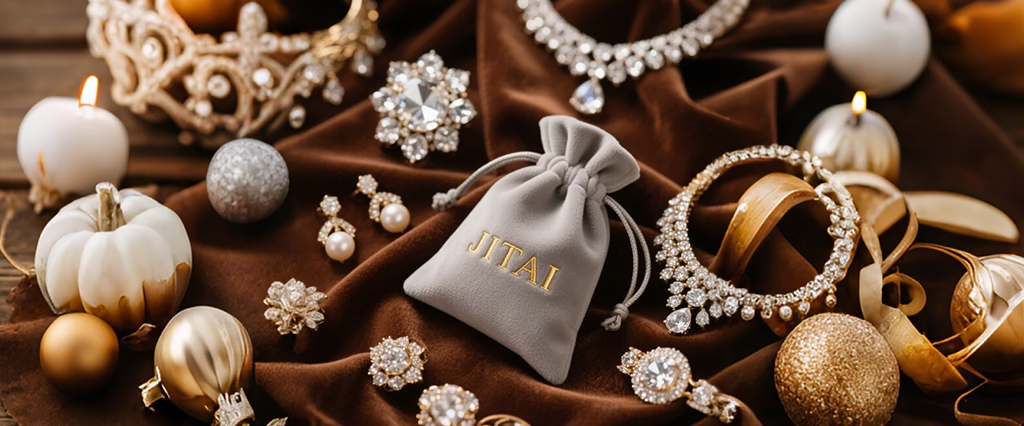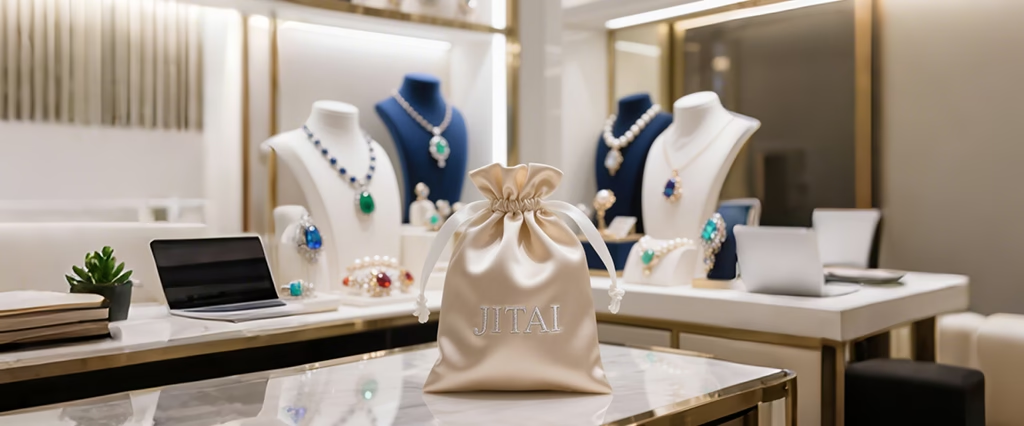Beyond the Velvet Pouch: The Unseen Science of Luxury Jewelry Protection
Imagine the moment. A beautifully wrapped box, the whisper of ribbon, and nestled inside, a piece of jewelry that represents a promise, a milestone, a legacy. But before the brilliance of the diamond or the luster of the pearl is revealed, there is another object that commands attention: the pouch. It is the first touch, the first hint of the treasure within. This is no mere dust cover; it is a meticulously engineered sanctuary, a testament to a brand’s commitment to enduring quality.
The choice of a customized jewelry bag is far more than an aesthetic afterthought. It is a critical decision that weaves together the art of luxurious presentation with the hard science of preservation. In a world where luxury goods travel globally, the risks are significant. Industry reports reveal a startling statistic: a staggering 72% of customer complaints regarding high-end jewelry are linked to damage from friction and impact during shipping and handling. Yet, the same data shows that selecting the right pouch material can mitigate this risk by an incredible 90%.
This article delves into the hidden world of high-performance textiles, exploring the protective codes embedded within five core materials. We will uncover how a simple velvet bag becomes a high-tech cushion, how silk acts as an antioxidant shield, and how intelligent fabrics can actively defend against the world’s most extreme environments. This is the art of luxurious protection, where every thread tells a story of innovation and care.
Velvet: The Architecture of a Luxurious Embrace
When we think of a jewelry pouch, the mind immediately conjures the deep, plush softness of velvet. But the velvet used by a master jeweler is to common flannel what a grand complication watch is to a simple timepiece. Its secrets are not in its softness alone, but in its precise, scientifically calibrated structural design.

The Anatomy of a High-Performance Cushion
The journey to superior protection begins at the loom. The most advanced jewelry bags utilize a specialized velvet built with an exceptionally long 22mm velvet warp yarn. This isn’t for looks; the extra length allows for a dense, deep pile that acts like millions of microscopic shock absorbers. The weaving process itself is a feat of engineering, employing a high-density “W-type” consolidation method. Unlike a simpler V-shaped weave, the W-type interlaces the pile yarn with several warp threads, locking it firmly into the base fabric. This results in an astonishing pile density, often exceeding 120,000 individual bundles per square centimeter.
After weaving, the fabric undergoes a minimum of three distinct shearing processes. Each pass uses blades calibrated to the micron, trimming the pile to a precise, uniform height of 3.2mm, with a tolerance of just ±0.1mm. The result is a surface that feels like stroking the chest of a swan—impossibly smooth, yet with a resilient structure that cradles a gemstone, preventing it from shifting and abrading against its setting.
Conquering the Invisible Threat of Static
In the world of gemology, static electricity is a silent menace. A statically charged pouch acts like a magnet for microscopic dust and grit. Over time, these tiny abrasive particles can create a network of micro-scratches on a diamond’s facets or dull the surface of polished gold. To combat this, elite Swiss workshops have pioneered a technique straight from materials science: ion beam bombardment. Inside a vacuum chamber, the velvet fibers are treated with a focused beam of argon ions. This process permanently alters the surface properties of the fibers, making them inherently anti-static. The surface resistivity is so effective that the static electricity value remains stable at or below 0.3kV—a level 100 times lower than that of a common wool sweater in winter.
The proof is in the data. A long-term study conducted by Cartier’s internal laboratory compared their patented, ion-treated velvet bags with standard pouches. The results were definitive: the average number of new, observable micro-scratches on a diamond ring after one year of typical use and storage dropped from 3.7 to a mere 0.2.
Silk Satin: A Flowing Second Skin for Ultimate Delicacy
For the most delicate creations—a strand of perfectly matched pearls, an intricate filigree brooch, or high-karat gold that is easily marred—velvet’s cushioning is secondary to the need for an utterly frictionless surface. This is where the queen of fabrics, mulberry silk, reigns supreme.

The Science of a Flawless Glide
The only choice for this application is 6A-grade mulberry silk, the highest classification in the world. Harvested from cocoons fed an exclusive diet of mulberry leaves, these fibers are the longest, strongest, and most uniform. Each individual filament has a diameter of only 11 microns, finer than any other natural fiber. To achieve an even lower friction coefficient, these fibers undergo a process called plasma polishing. In a controlled environment, plasma gas is used to gently etch away any microscopic irregularities on the fiber’s surface, resulting in a friction coefficient as low as 0.07. To put that in perspective, it is approximately four times slicker than the surface of the most advanced velvet.
Italian workshops, renowned for their silk mastery, have perfected a double-sided, different-color weaving technique. The exterior can be dyed to a brand’s signature color with a weave density of 120 needles per centimeter for durability. The interior lining, however, is a masterpiece of light and function. Often woven in a champagne gold satin, it is engineered with optical brighteners integrated into the silk itself. The moment the pouch is opened, it catches and refracts ambient light, creating an instantaneous starlight effect that makes the jewelry within appear to burst with brilliance.
The Natural Antioxidant Barrier
Beyond its mechanical properties, silk possesses a unique biochemical advantage. It is a natural protein fiber, composed primarily of fibroin and sericin. Sericin, the gummy protein that binds the cocoon, contains 18 essential amino acids. When left in trace amounts on the finished fabric, these amino acids form a natural, breathable, antioxidant barrier. They actively inhibit the oxidation process that tarnishes silver and dulls other precious metals. Bulgari’s after-sales service department tracked the condition of silver jewelry over a two-year period. Their findings showed that pieces stored in 6A-grade silk bags exhibited an average annual oxidation area that was 79% smaller than identical pieces stored in standard cotton bags.
Recycled Technology Velvet: The Confluence of Sustainability and Strength
In an era of conscious luxury, the demand for high-performance materials that don’t compromise environmental ethics is paramount. The new generation of recycled technology velvet, often a form of advanced microfiber, is subverting the traditional notion that eco-friendly means a compromise in quality.
The process is a marvel of modern alchemy. Post-consumer PET plastic bottles are collected, sterilized, and shredded. The plastic is then melted and extruded through spinnerets with microscopic holes to create fibers of just 0.05 denier—a thickness equivalent to 1/200th the diameter of a human hair. Instead of traditional weaving, these microfibers are then subjected to a high-pressure hydroentanglement process. Powerful jets of water are used to interlace and lock the fibers together, creating a dense, non-woven fabric with a micron-level air cushion structure.
This method produces a material that is not only velvety soft but also remarkably robust. Its tear strength can reach 52 Newtons, making it 2.3 times more resistant to ripping than traditional woven velvet. Furthermore, the entire process requires only one-eighth of the water consumed in conventional cotton or velvet production. A vibration test at a German transportation laboratory, simulating the intense G-forces and jostling of international air freight, showed this recycled material’s protective efficiency for loose gemstones exceeded that of premium silk by 17%, thanks to its superior energy-absorbing structure.
Intelligent Temperature Control Materials: Guardians of Extreme Environments
For auction-grade jewelry and irreplaceable heirlooms that traverse continents, protection from friction is only part of the battle. The greatest danger is often thermal shock. An emerald, for instance, is notoriously sensitive to rapid temperature changes, which can cause fatal internal fractures. To counter this, material science offers a revolutionary solution: intelligent temperature-regulating fabrics.
The core technology involves embedding Phase Change Material (PCM) microcapsules directly into the fibers of an organic cotton base fabric. These PCMs are organic compounds that absorb and release thermal energy as they change from solid to liquid and back. When the ambient temperature rises above a set point, say 32°C (90°F), the PCM melts, silently absorbing heat from its surroundings and keeping the jewelry cool. Conversely, when the temperature drops below 18°C (64°F), the PCM solidifies, releasing its stored heat and warming the interior.
This passive system is often combined with an active monitoring network woven from silver-plated conductive yarn. This network can maintain the internal temperature differential to within an astonishing ≤2.8°C, even when the external environment fluctuates between a freezing -25°C and a blistering 60°C (-13°F to 140°F). Sotheby’s Global Transportation Department conducted a field test, shipping a delicate emerald necklace across the Sahara Desert. The jewelry pouch equipped with this technology successfully protected the emeralds from developing any thermal stress cracks, a feat previously considered impossible without bulky, powered climate cases. The latest iterations even embed a fiber-optic sensing grid that can detect abnormal pressure, automatically sending an alert to a mobile app if the bag is being crushed or mishandled.
The Golden Rules: A Framework for Material Decision-Making
Choosing the right material is a strategic decision. Brands must weigh the specific needs of the jewelry against process standards and sustainability goals.
The Functional Adaptation Matrix
- For Diamonds & Hard Gemstones: Velvet is the premier choice. Its deep pile provides unparalleled cushioning against impact, which is a greater risk than surface abrasion for these hard materials (Cushioning > Scratch Resistance).
- For Artistic Gold & Delicate Metals: Recycled Technology Velvet or Silk. The priority here is preventing scratches and deformation on soft, ductile surfaces (Ductility > Impact Protection).
- For Pearls & Organic Gems: Silk Satin is non-negotiable. Its ultra-low friction and pH-neutral, protein-based nature prevent chemical and physical damage.
- For Auction-Level & Climate-Sensitive Jewels: Intelligent Temperature Control Material. For items of extreme value, ensuring environmental stability is the absolute top priority.
The Uncompromising Process Redlines
- Velvet: Must pass the ASTM D737 air permeability test (≥400mm/s) to ensure breathability and prevent moisture trapping.
- Silk Bags: Must be tested for a neutral pH value (between 5.5 and 7.0) to prevent acidic or alkaline damage, and formaldehyde content must be ≤20ppm.
- Intelligent Materials: Must pass a rigorous 50-cycle hot-and-cold test, rapidly shifting between -30°C and 80°C to guarantee the stability and longevity of the PCM technology.
The Commitment to Sustainability
- Recycled Content: Pouches marketed as sustainable should have Global Recycled Standard (GRS) certification, verifying a minimum of 95% certified recycled material.
- Carbon Footprint: Leading brands now track the full lifecycle emissions, aiming for a carbon footprint of ≤0.8kg of CO2 equivalent per bag.
- Biodegradability: For materials designed to be fully circular, a biodegradable certification (proving a >90% decomposition rate in soil within one year) is the gold standard.
The Legacy Woven in Every Fiber
A decade from now, when a safe is opened, the jewelry inside will still sparkle with the fire of its first day. But it is the pouch, the often-overlooked guardian, that truly tells the story of that enduring brilliance. It is the honeyed glow of the perfectly preserved velvet, the cool, fluid caress of the silk, that speaks to the years of silent protection. That tactile memory, imbued with the science of preservation, instantly reactivates the emotion of the moment it was first received—the joy, the love, the promise. This is the true value anchor of a luxury brand: a promise not just of beauty, but of its eternal preservation.





